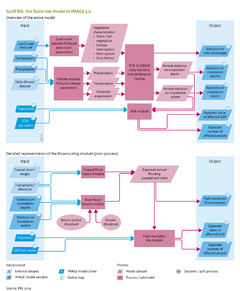Flood risks: Difference between revisions
Jump to navigation
Jump to search
ArnoBouwman (talk | contribs) No edit summary |
No edit summary |
||
| Line 6: | Line 6: | ||
|IMAGEComponent=land cover and use; | |IMAGEComponent=land cover and use; | ||
Human development | Human development | ||
|ExternalModel=PCR-GLOBWB model | |ExternalModel=PCR-GLOBWB model | ||
|KeyReference=Ward et al., 2012; Winsemius et al., 2012; | |||
|KeyReference=Ward | |||
Winsemius et al., 2012; | |||
|Reference=UNISDR, 2011; | |Reference=UNISDR, 2011; | ||
IPCC, 2012; | IPCC, 2012; | ||
Revision as of 15:59, 9 December 2013
| Component is implemented in: |
|
| Related IMAGE components |
| Models/Databases |
| Key publications |
| References |
Key policy issues
- How will future flood risk change as a result of socio-economic changes and climate change?
- What would be the impact of floods, in terms of damage and victims, and where are the hot spots?
- What would be suitable adaptation strategies and investment options related to flood risk?
